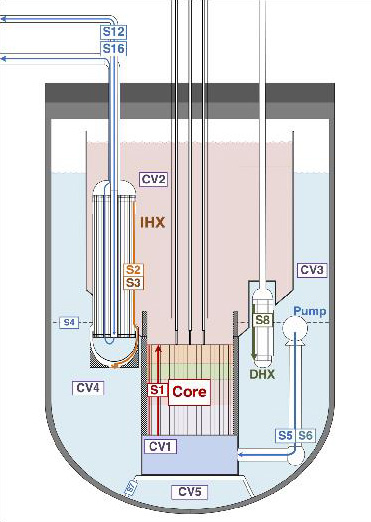Since its establishment in 1946, Argonne National Laboratory has ensured the safe, sustainable, and secure use of nuclear power worldwide. Argonne’s reactor design simulation software is central to our commitment to these founding principles.
Argonne National Laboratory developed the SAS4A/SASSYS-1 computer code for thermal, hydraulic, and safety analysis of power and flow transients in liquid-metal-cooled nuclear reactors (LMRs). With its origin as SAS1A in the late 1960s, the SAS series of codes has been under continuous use and development for five decades and represents a critical investment in advanced fast reactor safety analysis capabilities for the U.S. Department of Energy (DOE). SAS4A/SASSYS-1 is currently being used to perform transient safety analyses for the Versatile Test Reactor.

Capabilities
- Assesses the safety margins in design basis accidents (DBA) and consequences of beyond-design-basis accidents (BDBA).
- Analyzes the consequences of severe accidents with coolant boiling and/or fuel failures which are initiated by a very low probability coincidence of an accident precursor and failure of one or more safety systems.
Although SASSYS-1 and SAS4A were originally developed as separate computer codes, they have always shared a common code architecture, a similar data management strategy, and the same core channel representation. Subsequently, in the late 1980s, Argonne merged both codes into a single code referred to as SAS4A/SASSYS-1.
SAS4A/SASSYS-1 has been coupled to a variety of analysis and optimization tools, such as Star-CCM+, Dakota, RAVEN, SAM (the System Analysis Module under development as part of the U.S. DOE NEAMS program), and PDC (the Argonne Plant Dynamics Code that models Supercritical CO2 Brayton cycle for energy conversion). Several benchmark models have been developed for validation of whole-plant passive safety response based on EBR-II tests conducted in the 1980s. Two of these tests, Shutdown Heat Removal Tests 17 and 45R, are the basis of an IAEA Coordinated Research Project led by Argonne. DOE and Argonne are currently preparing additional validation models based on an FFTF passive safety demonstration test conducted in 1986.

Versions available
The code is currently supported on macOS, Windows, and Linux platforms with the x86 architecture. Source code is compliant with Fortran 2003 standards and can be compiled with any standards-compliant Fortran compiler.
The code manual and details on the latest code updates can be found on the SAS4A/SASSYS-1 public wiki.
Unique features
- Single-pin characteristic channel models for rapid evaluation of transients
- Detailed thermal-hydraulic sub-channel models for fuel assemblies
- Support for liquid-metal coolants such as sodium, NaK, lead and LBE, as well as other single-phase coolants
- Full-plant coolant system models to simulate passive heat removal and inherent safety
- Oxide and metallic fuel models for fuel melting, in-pin motion, pin failure, and ex-pin fuel dispersal and freezing
- Additional metallic fuel models for fuel-clad eutectic formation and cladding failure
- Reactor point kinetics with comprehensive treatment of reactivity feedback effects as per first-order perturbation theory
- High-fidelity decay heat models
- Built-in support for ANS standard decay heat properties
- Built-in support for alternative coolants in decay heat removal loops
- Support for line-based comments in input files
- Support for coupling to third-party computational fluid dynamics tools (such as STAR-CCM+) for representing thermal stratification in large volumes
- Support for coupling to DIF3D-K for reactor spatial kinetics
- Detailed reactor and plant control systems
How to obtain the code
To obtain a license for SAS4A/SASSYS-1, prospective users need to contact Argonne's Technology Commercialization and Partnerships Office.
A version of SAS4A/SASSYS-1 with a reduced feature-set, Mini SAS, is freely available for academic and non-commercial use under a general license agreement. Mini SAS is built from the same source as SAS4A/SASSYS-1, but excludes severe accident and steam plant models. It is also limited to five core channels, which is adequate for most analyses.
Relevant Publications
- G. Zhang, et al., “Dakota-SAS4A/SASSYS-1 Coupling for Uncertainty Quantification and Optimization Analysis,” in Proceedings of M&C 2017 – International Conference on Mathematics & Computational Methods Applied to Nuclear Science & Engineering, Jeju, Korea, 2017.
- T.H. Fanning and R. Hu, "Coupling the System Analysis Module with SAS4A/SASSYS-1", ANL/NE-16/22, ANL-ART-74, Argonne National Laboratory, September 2016.
- A.J. Brunett and T.H. Fanning, “Uncertainty Quantification in Advanced Reactors: The Coupling of SAS4A/SASSYS-1 with RAVEN and Dakota,” in Proceedings of the International Congress on Advances in Nuclear Power Plants (ICAPP 2016), San Francisco, CA, 2016.
- T. Sumner and A. Moisseytsev, “Simulations of the EBR-II Tests SHRT-17 and SHRT-45R,” in Proceedings of the 16th International Topical Meeting on Nuclear Reactor Thermal Hydraulics (NURETH-16), Chicago, IL, 2015.
- A. Moisseytsev and J. Sienicki, “Dynamic Analysis of SCO2 Cycle Control with Coupled PDC-SAS4A/SASSYS-1 Codes,” in Proceedings of the 20th International Conference on Nuclear Engineering (ICONE20), Anaheim, CA, 2012.
- J. W. Thomas, et al., “Validation of the Integration of CFD and SAS4A/SASSYS-1: Analysis of EBR-II Shutdown Heat Removal Test 17,” in Proceedings of the International Congress on Advances in Nuclear Power Plants (ICAPP 2012), Chicago, IL, 2012.
Protected Loss of Flow Transient Simulation
Tests carried out by Argonne were used to perform validation for advanced safety simulations, such as the one shown here from SAS4A/SASSYS-1. This image shows the calculated fuel, cladding, coolant, and structure temperatures for the XX09 experimental assembly and its six neighbors during a full-power loss of flow accident.